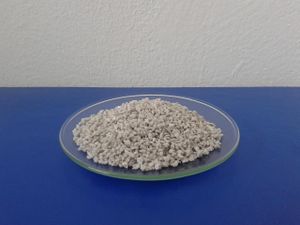Pumice
Pumice, also called pumicite in its powdered or dust form, is a type of light colored volcanic rock that consists of highly vesicular rough textured volcanic glass, which may or may not contain crystals. Pumice consists mostly of calcium silicate.
Contents
Properties
Pumice is a white-light grayish solid, lighter than water (0.25 g/cm3 the most common density).
Being a volcanic glass, pumice shows good resistance many corrosive acids such as sulfuric and hydrofluoric acid (due to the formation of an insoluble layer of calcium sulfate and calcium fluoride), though hydrochloric acid will attack pumice.[1]
Availability
Pumice can be bought from many beauty stores and home improvement retailers.
Avoid buying from "suspicious looking places", as many "pumice stones" they sell are fakes, being most often just blocks of autoclaved aerated concrete.
Lastly pumice grains can be purchased from chemical suppliers and online.
Projects
- Boiling chips
- Make lightweight concrete
- Use as abrasive
- Hydroponics
Handling
Safety
Pumice is practically nontoxic in bulk. Pumice dust however, is abrasive and irritant to eyes and skin. It may lead to lung problems if inhaled.
Storage
No special storage is required, it can be stored in any container or bottle.
Disposal
No special disposal is required. Discard it as you wish.
